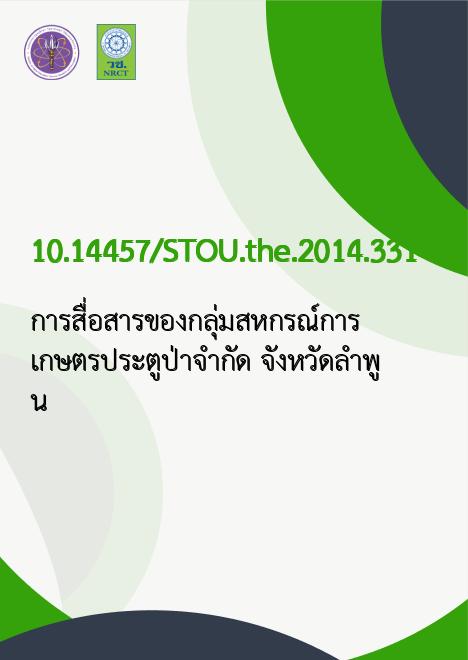
|
การสื่อสารของกลุ่มสหกรณ์การเกษตรประตูป่าจำกัด จังหวัดลำพูน |
|---|---|
| รหัสดีโอไอ | |
| Title | การสื่อสารของกลุ่มสหกรณ์การเกษตรประตูป่าจำกัด จังหวัดลำพูน |
| Creator | ศรีจิต เองเลอร์ |
| Publisher | มหาวิทยาลัยสุโขทัยธรรมาธิราช |
| Publication Year | 2557 |
| Keyword | การสื่อสารทางการเกษตร, การศึกษาอิสระ--นิเทศศาสตร์, มหาวิทยาลัยสุโขทัยธรรมาธิราช. สาขาวิชานิเทศศาสตร์--การศึกษาเฉพาะกรณี, เกษตรกร--ไทย--ลำปาง, มหาวิทยาลัยสุโขทัยธรรมาธิราช. แขนงวิชานิเทศศาสตร์--การศึกษาเฉพาะกรณี |
| Abstract | การศึกษาค้นคว้าอิสระนี้มีวัตถุประสงค์เพื่อศึกษา 1) กระบวนการสื่อสารของกลุ่มเกษตรกร สหกรณ์การเกษตรประตูป่าจำกัด จังหวัดลำพูน 2) จุดแข็ง จุดอ่อน โอกาสและภาวะคุกคามของกลุ่มเกษตรกร สหกรณ์การเกษตรประตูป่าจำกัด จังหวัดลำพูน 3) ข้อเสนอแนะด้านการสื่อสารของกลุ่มเกษตรกร สหกรณ์การเกษตรประตูป่าจำกัด จังหวัดลำพูนการศึกษาวิจัยครั้งนี้เป็นการวิจัยเชิงคุณภาพ ผู้ให้ข้อมูลหลักได้มาโดยการเลือกแบบเจาะจง จำนวน 17 คน ประกอบด้วย แกนนำกลุ่ม จำนวน 1 คน คณะกรรมการสหกรณ์การเกษตรประตูป่าจำกัด จังหวัดลำพูน จำนวน 13 คน และเจ้าหน้าที่รัฐ กลุ่มส่งเสริมและพัฒนาธุรกิจสหกรณ์สำนักงานสหกรณ์การเกษตร จังหวัดลำพูน จำนวน 3 คน เครื่องมือที่ใช้ในการวิจัย คือ แบบสัมภาษณ์เชิงลึก และวิเคราะห์ข้อมูลโดยการพรรณนาวิเคราะห์ผลการวิจัยพบว่า 1) กระบวนการสื่อสารของกลุ่มเกษตรกร สหกรณ์การเกษตรประตูป่าจำกัด จังหวัดลำพูนประกอบด้วย (1) ผู้ส่งสาร คือ แกนนำกลุ่ม คณะกรรมการสหกรณ์ และเจ้าหน้าที่รัฐ (2) สาร เป็นเนื้อหาที่ใช้เพื่อให้ข้อมูล ความรู้ และการต่อรองด้านผลผลิต (3) สื่อประกอบด้วย สื่อบุคคล สื่อกิจกรรม สื่อเฉพาะกิจ สื่อมวลชน และสื่อใหม่ (4) ผู้รับสาร คือเกษตรกรชาวสวนลำไย 2) สหกรณ์การเกษตรประตูป่าจำกัด จังหวัดลำพูน มีจุดแข็ง คือ การรวมกลุ่มที่เข้มแข็ง จุดอ่อนคือ มีเงินทุนหมุนเวียนน้อย โอกาสคือ ความช่วยเหลือจากทางภาครัฐทั้งด้านงบประมาณ วิชาการ การหาตลาดและแหล่งทุน ภาวะคุกคามคือ ความไม่แน่นอนของตลาดและการเอารัดเอาเปรียบจากพ่อค้าคนกลาง 3) ข้อเสนอแนะด้านการสื่อสารของกลุ่มเกษตรกรสหกรณ์การเกษตรประตูป่าจำกัด จังหวัดลำพูน คือ การพัฒนาความรู้ด้านการสื่อสารให้ทันสมัยและการนำเทคโนโลยีมาบูรณาการในการสื่อสารเพื่อให้เกิดประโยชน์อย่างสูงสุด || The objectives of this research were to study 1 ) the communicationsprocess of members of Pratu Ba Agricultural Cooperative, Limited, in Lamphun Province; 2) the cooperative's strengths, weaknesses, opportunities and threats; 3) recommendations for improving the group's communications. This was a qualitative research. The 17 key informants, chosen through purposive sampling, consisted of 1 core leader of Pratu Ba Agricultural Cooperative, Limited, in Lamphun Province, 13 members of the cooperative's board of directors, and 3 government officials who worked for the Lamphun Province branch of the Agricultural Cooperative Promotion Office and were in charge of promoting and developing the cooperative business. Data were collected using an in-depth interview form and analyzed through descriptive analysis. The results showed that 1) the communications process consisted of (a) the message senders, who were the group's core leaders, members of the cooperative's board of directors, and government officials; (b) the messages, which were mainly informative content or content concerning bargaining for agricultural produce prices; (c) the media, which were personal media, activities, ad hoc media, mass media and new media; and (d) the message receivers, who were lamyai orchard owners. 2) The main strength of Pratu Ba Agricultural Cooperative was the strength of its group cohesion. Its main weakness was a shortage of working capital. The cooperative had opportunities in the form of possible assistance from the government sector in terms of budget, academic support, marketing assistance, and sources of capital. The threats to the cooperative's success were the uncertainty of the market and attempts by middle men to take advantage of the farmers. 3) Recommendations for improving the cooperative's communications were to develop greater knowledge of modern communications methods and to integrate technology into the communications process for greater benefit. |
| URL Website | https://repository.stou.ac.th |
| Website title | STOU Digital Repository |